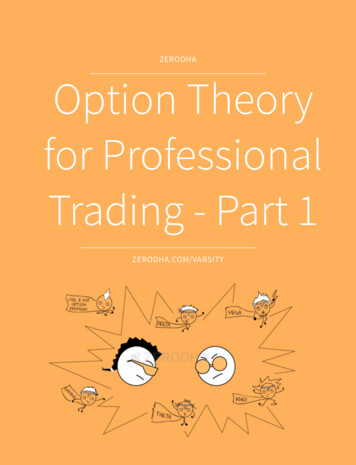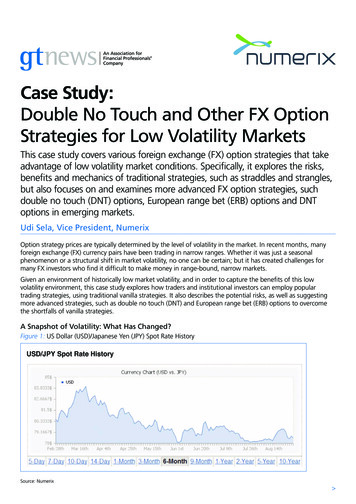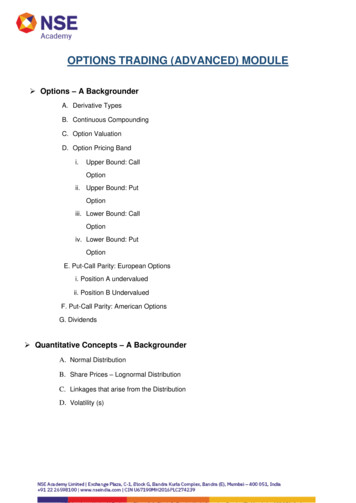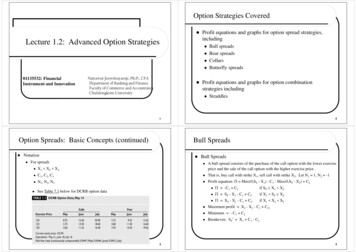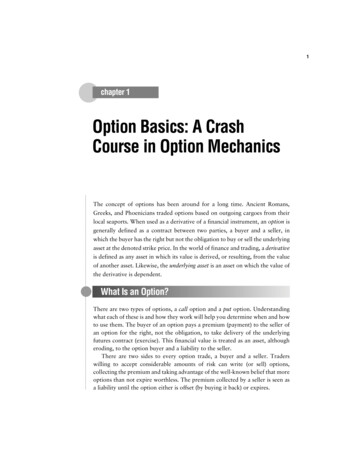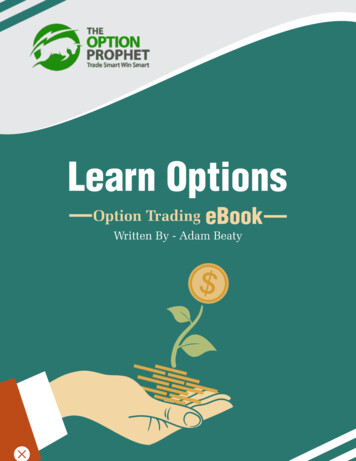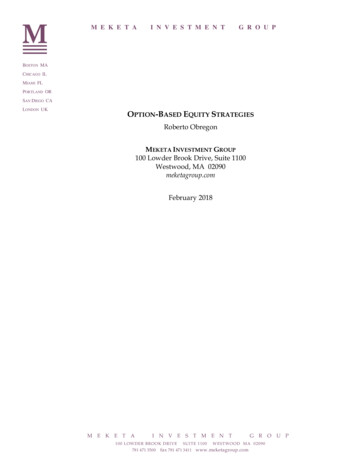
Transcription
“USE OF OPTION STRATEGIES TO IMPROVE RISK-ADJUSTED RETURNS ON A 60/40INVESTMENT PORTFOLIO.”Carlos Chujoy1Joy Seth2Satitpong Chantarajirawong3July 2016ABSTRACTImprovement of risk-adjusted returns is one of many goals that pension plans seek toachieve. Many plans that follow a Traditional 60/40 dollar allocation to stocks and bonds end upexhibiting a large concentration of risk to stocks given their higher volatility characteristic. Thestudy aims to explore a variety of strategies that incorporate options as a way to improve a plan’sreturns/risk outcomes. In doing so, it also aims to provide a general view of how these strategiesperform during the different stages of the business cycle and volatility regimes when they areused in combination with a plan’s stock/bond allocation.ACKNOWLEDGEMENTS: The authors would like to thank the following people for theircontribution and valuable input: Michael Warsh, Paul Stephens, Matt Moran from the ChicagoBoard Options Exchange, the executive office and Stuart Williams from the EmployeesRetirement System of Texas for their support and Yu Tang, intern from the University ofWashington. All errors and omissions remain the responsibilities of the authors.1Head of Risk Management & Applied Research, Employees Retirement System of TexasInvestment Analyst, Employees Retirement System of Texas3Investment Analyst, Employees Retirement System of Texas2Page 1
IntroductionPublic pension plans in the US have traditionally held an investment allocation of 60% ofits assets to equities and 40% to fixed income. This dollar allocation stems from the fact thatpension plans need to grow their assets as well as shield their investments from the erosion ofpurchasing power over time. At the same time, one of their main goals is to generate investmentreturns that are commensurate with the amount of risk incurred.Exhibit 1 below, shows the cumulative performance for stocks, bonds and a typical 60/40plan. For purposes of this exercise, we have used the Vanguard S&P 500 Index Fund (VFINX)from the Yahoo Financial database to represent domestic equities, and for fixed income we haveused the BofA Merrill Lynch US Corp Master Total Return Index Value from the FederalReserve Bank of St. Louis database. At first glance, one can notice how closely related equityreturns are to a typical 60/40 allocation. One can also notice that the growth trajectory of planassets comes in at the expense of increased volatility due to market corrections. Marketcorrections that exert amongst other things, the decline of a plans’ market value, the liquiditationof assets at the wrong time to meet internal obligations, the compromise of the overall soundnessof the plan and sometimes its viability as an on-going concern.The need to diversify market risk has been a very important one and one that plans havesought in order to improve their risk-adjusted returns. Over the years, plans have relied ondiversifying their investments into non-traditional asset classes, and more recently in framingtheir investment opportunities in terms of risk premia as opposed to asset classes to increase aplan’s portfolio diversification.Page 2
In terms of risk, Exhibit 2, provides a graphical representation of the evolution ofportfolio drawdowns. As noted earlier, a Traditional 60/40 plan as represented by the black linewill have its performance results be heavily influenced by the returns of the equity asset class.Exhibit 3, summarizes the results of the past 25 years. It shows that Equities havedelivered strong returns at high levels of risk and large drawdowns.At the same time, it shows that US Bonds have delivered lower returns relative to stocksbut have attained them with a lower amount of risk. Lastly, the Traditional 60/40 plan’s returnand risk metrics fall right in the middle of the aforementioned asset classes. It is clear that a60/40 plan’s statistics are heavily influenced by the equity asset class; a tilt that a plan relies toachieve the growth of its assets throughout time.Page 3
A final observation is that all portfolios exhibit fat tails (excess kurtosis is positive) andlong left tail (negative skew) in their return distributions4.To further support the thesis of high equity concentration of risk, Exhibit 4 shows that a60/40 dollar allocation translates to a risk allocation of approximately 92/8 percent. The higheramount of volatility of the equity asset class returns, affects its percent contribution to totalportfolio risk more than proportionately.Exhibit 4: Dollar and Risk AllocationBased on these results, can risk-adjusted returns be improved for a Traditional 60/40portfolio, and if so, how? Over the years, some have suggested the higher level of dispersion ofreturns in the equity asset class provides a window of opportunity for option-based strategies toassist 60/40 plans achieve their risk-adjust return goals. In fact, academics and practitioners5have generally come to consensus that the incorporation of option strategies can help with thegoal of tail risk mitigation, improvement of total risk levels, increase of total returns and overallimprovement of risk-adjusted returns. The main subject of this study examines if equityconcentration risk can be mitigated by using option-based strategies.The following section provides an overview of selected option-based strategies thatinvestors might consider as part of their investment program. We note that option-basedstrategies are being used for purposes of protection against downside risk, as well as for totalreturn enhancement. We expect that the use of option-based strategies would help to answerthese questions.4Please refer to Appendix A where we use QQ plots to compare the shape of the distributions (location, scale andskewness) between two sets of data. The QQ plot provides a graphical visualization of the quantiles of theprobability distribution of a strategy to the theoretical normal distribution.5As noted by Schneeweis and Spurgin on “The Benefits of Index Option-Based Strategies for InstitutionalPortfolios,” and Asset Consulting Group in “An Analysis of Index option Writing for Liquid Enhanced RiskAdjusted Returns”Page 4
Historical Returns of Option-Based StrategiesBelow is a list of 11 option-based strategies that have been grouped into 2 categories;first, those that help with downside protection, in other words, these are strategies that help tomitigate portfolio risk during market downturns, and second, those that that provide incomeenhancement, which are strategies that seek to improve the total return of a portfolio byexpanding its yield via options. When confronted with strategies that exhibit similar pay-offs, weselected the one that provided either the least cost or yielded a positive premium. An example ofthis is the case of a bearish spread. This spread can be implemented either through puts or calls.Since implementing the bearish spread through puts is more costly than one with calls as theBear Put Spread requires a cash outlay for establishing the position, we considered the spreadthat uses call options for purposes of conducting the research. It is also worth noting that theoption-based strategies selected have been done on an arbitrary basis and are intended toillustrate the notion of downside protection and income enhancement.Downside Protection Option-Based strategies Bear-Call Spread – Sell an ATM strike Call option and purchase a 104% OTM strikeCall option. Short Risk Reversal – Sell a 102% OTM Call option and purchase a 96% OTM Putoption. Long Iron Condor – Sell a 96% OTM Put and 104% OTM Call (4% OTM Strangle) andpurchase a 98% OTM Put and a 102% OTM Call (2% OTM Strangle) Long Put – Purchase a 96% OTM Put Long Strangle – Purchase a 104% OTM Call and a 96% OTM Put. Put Spread Collar – Sell a 102% OTM Call, purchase an ATM Put and sell a 96% OTMPutIncome Enhancement Option-Based strategies Short Straddle – Sell an ATM Call and sell an ATM Put Bull Put Spread – Purchase a lower 96% OTM Put strike and sell a higher ATM Putstrike Short Call – Sell a 102% OTM Call Short Put – Sell a 96% OTM Put Short Iron Condor – Purchase a 96% OTM Put and 104% OTM Call (4% OTM Strangle)and sell a 98% OTM Put and a 102% OTM Call (2% OTM Strangle)Page 5
Exhibit 5 shows cumulative returns for the 11 option-based strategies under studyincluding the Traditional 60/40 portfolio. Monthly data from the Chicago Board OptionsExchange were used to calculate the returns6 for the various option-based strategies under study.In the context of this study, the option-based strategies are treated as overlay portfolios andassume a notional of 25% of the total assets of the Traditional 60/40 portfolio. Moreover, thedollars invested in the options overlay represent a fraction of the 60/40 and include the premiumand margin required to establish the position. This calculation is explained in more detail in theportfolio construction process of this paper as well as in appendix B. Exhibit 5 shows thecumulative returns of the combined returns.We then look at how each strategy performed during different market cycles. In Exhibit6, we show the results of the option-based strategies used for downside protection. We used theperiod of August 2000 through September 2002 to depict a down market.7 The results show thatfrom a total return standpoint, all of the downside protection strategies selected performed betterthan having been invested in either the S&P500 or the Traditional 60/40.Comparing the results to the Traditional 60/40 stock/bond allocation, all of the optionbased strategies produced lower risk and better drawdown. Total risk ranged from as low as8.24% for the Short Risk Reversal and as high as 14.06% for the Long Iron Condor. In terms of6Please refer to Appendix B for further reference in the return calculation used for the option-based strategiesTo depict a down market, we arbitrarily selected one of the periods used in the April 2016, CBOE presentationtitled New Studies on Uses of Options – Protection, and Enhancing Income and Risk-Adjusted Returns by MattMoran. P1.7Page 6
drawdowns, they ranged from as low as 11.66% for the Put Spread Collar (making it the bestdrawdown mitigating strategy) to as high as 20.45% for the Long Iron Condor respectively.Exhibit 7 shows the results for the option-based strategies used for income enhancement.The strategies selected were the Short Iron Condor, Bull Put Spread, Short Put, Short Straddleand Short Call. We used the period of December 2003 through December 2004 to depict a rangebound to flat market. In this case, we can observe that the three best option-based performingstrategies were the Short Put, the Bull Put Spread and the Short Straddle in that order.Additionally, the risk-adjusted returns for the Short Straddle, Short Call, Short Put and Bull PutSpread were higher than for the Traditional 60/40, indicating that it would be to the advantage ofa 60/40 plan to incorporate these strategies as part of its portfolio mix.In a similar fashion, we also conducted the same type analysis during a strong marketcycle. We noticed that the income enhancement strategies did particularly well in this instanceand we summarized the results in Appendix D.Page 7
Exhibits 8a and 8b illustrate the evolution of drawdowns for all strategies (downsideprotection and income enhancement) over the past 25 years ending March 2015. The strategies with the least drawdowns were the Short Risk Reversal, Put Spread Collarand Long Put. While strategies with the largest drawdowns included the Short Put, Bull Put Spread andthe Short Straddle. A common characteristic amongst them all was that the drawdownstook place almost at the same time and with similar levels of intensity.Page 8
Diversification AnalysisThe results shown in the preceding section suggest that a Traditional 60/40 plan canbenefit from the use of option-based strategies to enhance its risk-adjusted returns. The studynow turns to an analysis of correlations for all strategies to ascertain if diversification of totalportfolio risk is a possibility.Exhibit 9 shows the correlation level of excess returns for the option-based strategiesduring a market downturn (August 2000-September 2002). The correlation plot provides a clearview that the correlation for most of the option strategies across groups (downside protection andincome enhancement) is negative; and another where the correlations intra group is high. Forexample across groups, the most negatively correlated strategies can be found between the ShortPut vs. Long a Put and Long a Strangle; and within each group, the highest correlated strategieswere found to be in the Long Put vs. the Risk Reversal, and the Long Put vs. the Long Strangle.Page 9
While Exhibit 9 provided a snapshot of correlations for a given time period, Exhibits 10aand 10b show how correlations evolved over the past 25 years. A close look at the chart revealsthe behavior of three major trends; strategies that show correlation levels north of 0.5, strategiesthat show correlations less than -0.5 and those in between -0.5 and 0.5. Option strategies withcorrelations less than -0.5 have shown to display a pretty stable pattern over time, suggestingthey could be good candidates for portfolio diversification. These strategies were the Short RiskReversal, the Put Spread Collar, the Short Call and the Bear Call Spread. The only optionstrategy that showed a persistent correlation of 0.5 to a 60/40 was the Bull Put Spread.Page 10
Page 11
Exhibit 11 shows a scatter plot of returns/risk for all strategies over the past 25 yearsthrough March 2015.From the Exhibit above we note that: All 11 overlay option-based strategies produced positive returns.The best performing strategies included the Bull Put Spread, Short Put and ShortStraddle. The higher returns also came with a slightly higher degree of risk relative to theTraditional 60/40 portfolio.The Short Risk Reversal produced the least amount of performance but it also incurredthe least amount of total risk.The Long Iron Condor and Short Iron Condor generated returns and risk levels that werevery similar to a Traditional 60/40 portfolio.Up to this point, the research focused on the need to diversify portfolio risk to theTraditional 60/40 portfolio. The equity asset class was identified to be the largest contributor tototal portfolio risk and selected option-based strategies were analyzed to determine if they couldimprove risk-adjusted returns. We found that investors utilize options in a couple of ways: toprotect portfolio returns during market downturns and to enhance portfolio income. Two distinctgroups of option strategies were created to address these needs and they were analyzed under amarket period of duress and during a market period of range bound to flat returns. The keytakeaways of the study suggested that:Page 12
1. During stressful markets, in general the downside protection option-based strategiesdelivered better performance, lower risk and better drawdowns relative to the Traditional60/40 portfolio.2. During range-bound to flat markets, the income enhancing option-based strategies alsodelivered better relative performance and risk metrics.3. Correlation levels were negative amongst these two groups suggesting that their inclusionin a portfolio would tend to diversify portfolio risk. This was shown by static and rollingcorrelation analysis. Likewise the rolling correlation levels for the downside protectionstrategies relative to the Traditional 60/40 portfolio were found to be stable over time,further reinforcing the idea that these strategies could be considered as part of theTraditional 60/40 portfolio mix to improve risk-adjusted returns.In addition to stressful and range-bound to flat markets, the research study covered aperiod of strong market returns; the results of which can be found in Appendix D. During abullish market, we observed that all of the income enhancement strategies produced returnsabove and beyond those attained by a Traditional 60/40 portfolio. Moreover, we found that therisk-adjusted returns were generally better. Downside protection strategies did not do as wellduring this period as they are generally designed to perform during stressful markets.With these results in hand, the study now aims to explore the use of economic data andvolatility regimes that in conjunction with the option-based strategies may help the returns of aTraditional 60/40 portfolio.Portfolio Construction using Option-Based Strategies under a Regime-Based ApproachPortfolio construction can be approached in a variety of ways. For example, an investormight choose to use a bottoms-up analysis, a systematic process or a top-down approach whenconstructing portfolios. In our case, we decided to apply a systematic, top-down portfolioconstruction process; whereby the top-down view is expressed through the use of economic datasuch as an economic indicator and a volality index. To complement this process, we use a set ofrules to select option strategies that vary based on current economic regimes. We then applythese set of rules on a systematic basis over the entire investment period.Page 13
The Business Cycle, Volatility Regimes and Portfolio Modeling Exhibit 12 shows the Conference Board Leading Economic Indicator (LEI)8. Anindicator that is used as a proxy for the business cycle. A reading above 1 indicates that theeconomy is growing while a reading below 1 indicates that the economy is contracting. Thedifferent shades of colors in the Exhibit represent the different stages of the business cycle.Green depicts expansion, yellow represents slowdown, red defines contraction and bluecharacterizes recovery.The VIX 9 is used as a proxy for expected volatility. A high volatility regime is definedas one where the VIX is trading above its long-term mean whereas a low volatility regime isdefined as one where the VIX is trading below that mean. The red shade in Exhibit 13 highlightsa regime of high volatility whereas a green shade depicts a low volatility regime.A regime signal is created using current data. For instance, when the LEI is trendingabove 1 with an upward trend, we characterize this regime as an economic expansion. When wecombine the expansionary phase with a VIX reading that is below its long-term mean, in otherwords when the volatility environment is low, the regime is defined as expansion plus lowvolatility. We repeat this process to characterize all possible combination of regimes and8The Conference Board Leading Economic Indicator (LEI) is a registered trademark of The Conference Board,Inc. This indicator is used to reveal common turning point patterns in economic data.9VIX is a registered trademark of the Chicago Board Options Exchange, Incorporated (CBOE). The VIX is used asa measure of the market’s expectation about the stock’s market volatility over the next 30-day period.Page 14
compute a series of statistics such as the annualized excess returns, hit rates10 and informationratios for all strategies within each regime environment. Exhibit 14 below summarizes the results of the regime-based analysis11. For exampleunder an economic slowdown and high market volatility, one can observe that the incomeenhancement strategies have done well over time.The preceding results lead us to determine if a combination of regimes such as the onedescribed above and the use of option-based strategies helped to improve the outcomes of aTraditional 60/40 portfolio. This is the area of focus for the next section of the study.1011We calculate the hit rate as the percentage of times a strategy outperforms the Traditional 60/40 portfolio.Please refer to Appendix C for hit rates and information ratios.Page 15
Portfolio ConstructionWe construct two model portfolios; one that incorporates the regime-based signal appliedto the 60/40 portfolio and a second one that adds option-based strategies in its composition.The regime-based portfolio with option-based strategies is constructed as follows1. Rank the selected option-based strategies based on annualized excess return, informationratio and hit rates,2. Select the best two option-based strategies from step 1,3. Set 25% notional of the fund’s AUM, and divide equally between the strategies from step2,4. Calculate the number of contracts based on notional and spot,5. Calculate margin requirements for each strategy as per CBOE guidelines,6. Calculate premium amount for each strategy,7. Calculate dollar allocation to Traditional 60/40 by netting out the margin and premiumfrom the current AUM,8. Calculate the payoff for each option-based strategy as per the Formula Definition table inAppendix B, and9. Compute the returns based on the changes in the AUM (refer to Appendix B).Exhibit 15 shows an out-of-sample backtest of how the modeled portfolios haveperformed relative to a Traditional 60/40 stock/bond portfolio. The backtest period starts May1990 and ends March 2015. A one-month ahead forecast was applied to determine the regimeenvironment and portfolios were rebalanced when the forecast signal changed.Page 16
The graph provides evidence that the combination of economic data with volatilityregimes and option-based strategies can add incremental value in the portfolio constructionprocess.Exhibit 16 shows the drawdown curves for all portfolios while Exhibit 17 summarizes theresults for the backtest. The results show that the regime-based plus option-based strategiesprovide a superior return profile over the Traditional 60/40, with an increased level of riskadjusted returns.Page 17
Page 18
ConclusionThe study noted that a Traditional 60/40 plan is prone to high equity concentration ofrisk. In fact, the research showed that a 60/40 dollar allocation translates to a risk allocation ofapproximately 92/8 percent. This is evidence that the higher amount of volatility of the equityasset class returns, affects its percent contribution to total portfolio risk more thanproportionately.Investors utilize options in a couple of ways: to protect portfolio returns during marketdownturns and to enhance portfolio income. Two distinct groups of option strategies werecreated to address these needs and they were analyzed under a market period of duress andduring a market period of range bound to flat returns. The study found that in general optionbased strategies delivered better performance, lower risk and better drawdowns relative to theTraditional 60/40 portfolio.Portfolio construction can be approached in a variety of ways. For example, an investormight choose to use a bottoms-up analysis, a systematic process or a top-down approach whenconstructing portfolios. The study chose to use the LEI and VIX as the preferred signals to driveeconomic regimes though it was noted that any other set of drivers could have been used as well.The research showed promising results when using economic data and volatility regimes incombination with option-based strategies to augment the value of a portfolio.Page 19
Appendix A – QQ plotsWe use QQ plots to compare the shape of the distributions (location, scale and skewness)between two sets of data. The QQ plot provides a graphical visualization of the quantiles of theprobability distribution of a strategy to a theoretical distribution. In this case, we are using thenormal distribution as our theoretical. A point (x, y) on the plot corresponds to one of thequantiles of the strategy distribution (y-coordinate) plotted against the same quantile of thetheoretical normal distribution (x-coordinate).The light gray line depicts a goodness of fit between the quantiles of the empirical andnormal distribution. If the light green points lie on the gray line, the distributions are similar innature. Fat tails occur when on the extremes the light green dots deviate from the gray line.Page 20
Appendix A – QQ plots (continued)For example the short straddle, exhibits a long thick negative tail.Page 21
Appendix B – Calculation of Returns for Option-Based StrategiesTo calculate returns for all of the option-based strategies, we referred to the ChicagoBoard Options Exchange data and used the following steps. No transaction costs were includedand have used mid prices for both the long and short transactions.1. Set notional to 25% of the current assets under management for the Traditional 60/40portfolio2. Calculate the number of contracts based on notional and spot3. Calculate margin requirements as per CBOE guidelines4. Calculate premium amount5. Calculate dollar allocation to Traditional 60/40 by netting out the margin and premiumfrom the current AUM6. Calculate the payoff for the option-based strategy as per the Formula Definition table7. Calculate returns using the following stepsAUMt 1 AUM 60/40t x (1 r) Options PnL Margint x (1 rf)where,r 60% x Stock return 40% Bond returnOptions PnL Pay off – PremiumMargin varies by strategy as per CBOE guidelinesReturn (AUM t 1 /AUM t) - 1Page 22
Page 23
Appendix C – Regime Based AnalysisPage 24
Appendix D – Table of Performance and Risk Measures during a Strong MarketThe tables below show the performance statistics for the Downside Protection Strategies and theIncome Enhancement Strategies during a period of strong market returns.Page 25
ReferencesDouglas, Fabrice and Vainberg Gregory. Option Pricing Models & Volatility. Wiley, 2007.Hull, John. Options, Futures and Other Derivative Securities. Prentice-Hall, 1989.Illmanen, Antti. Expected Returns: An Investor’s Guide to Harvesting Market Returns. Wiley,2011.Kritzman, Mark. “Are Optimizers Error Mazimizers?” Journal of Portfolio Management 32, no 4(2006):66-69Larcher, Gerhard, Del Chicca Lucia and Szolgyenyi Michaela. “Modeling and Performance ofCertain Put-Write Strategies.” Journal of Alternative Investing 15, no 4 (2013):74-86Markowitz, Harry. “Portfolio Selection.” Journal of Finance 7, no. 1 (1952):77-91.O’Connell, Martin. The Business of Options. Wiley, 2001.Scherer, Bernd, and Martin Douglas. Introduction to Modern Portfolio Optimization withNuOPT, S-PLUS and S Bayes. Springer, 2005Schneeweis, Thomas and Spurgin Richard. “The Benefits of Index Option-Based Strategies forInstitutional Portfolios.” Journal of Alternative Investing 3, no 4 (2001):44-52Ungar, Jason and Moran Matthew. “The Cash-Secured PutWrite Strategy and Performance ofRelated Benchmark Indexes.” Journal of Alternative Investments 11, no. 4 (2009):43-56Zivot, Eric and Wang Jiahui. Modeling Financial Timer Series with S-PLUS. Springer, 2006Yang, George. Buy-Write or Put-Write: An Active Index Writing Portfolio to Strike it Right.Available at SSRN 1827363 (2011)Page 26
Historical Returns of Option-Based Strategies . Below is a list of 11 option-based strategies that have been grouped into 2 categories; first, those that help with downside protection, in other words, these are strategies that help to mitigate portfolio risk during market downturns, and second, those that that provide income

